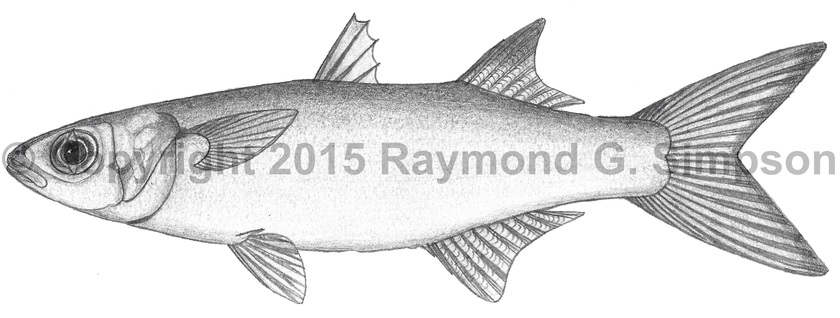
Common Name
Redeye Mullet
Year Described
Harrison, Nirchio, Oliveira, Ron, & Gavíria, 2007
Identification
Dorsal Fin: IV, 9
Anal Fin: III, 9
Pectoral Fin: II, 14-15
Lateral Scale Rows: 35-38
Transverse Scales: 12-13
Circumpeduncular Scales: 17-18
Gill Rakers: 65-71 (lower limb of first arch)
Body elongate; cylindrical anteriorly and becoming more compressed posteriorly. Snout narrowly blunt. Top of head flat. Eye diameter slightly greater than snout length. Subterminal mouth reaches anterior margin of orbit. Teeth with slightly curved tips. Adipose eyelid present (absent in juveniles). Spiny dorsal fin situated at mid-point of body. Anal fin inserted slightly forward of or even with second dorsal fin. Dorsal and anal fins densely covered with small scales. Pectoral fin high on side and not reaching dorsal fin origin. Tail forked. Body scales with minute spines.
Color
Body whitish grading to darker dorsally. Can show faint stripes but usually pale. A small gold spot on upper opercle. Spiny dorsal fin with an obvious dark spot. Soft dorsal fin and tail with dense dark melanophores and quite dusky. Tail with a thin dark margin. Pectoral fins with melanophores. Pelvic and anal fins uniformly yellowish to pale. A small blotch on the pectoral base and axil. Eye red in life.
Size
Maximum size to 26cm SL
Habitat
Found inshore and in estuarine waters.
Range
Known from off N. South America from Panama to N. Brazil. May occur more widely in the Atlantic with additional study of white mullets from the area.
References
Durand, J.D., K.N. Shen, W.J. Chen, B.W. Jamandre, H. Blel, K. Diop, M. Nirchio, J.J. Garcia de Léon, A.K. Whitfield, C.W. Chang & P. Borsa. 2012. Systematics of the grey mullets (Teleostei: Mugiliformes: Mugilidae): Molecular phylogenentic evidence challenges two centuries of morphology-based taxonomy. Molecular Phylogenetics and Evolution, 64, 73–92.
Harrison I.J., M. Nirchio, C. Oliveiras, E. Ron & J. Gaviria. 2007. A new species of mullet (Teleostei: Mugilidae) from Venezuela, with a discussion on the taxonomy of Mugil gaimardianus. J. Fish Biol. 71: 76-97.
Menezes, N.A., M. Nirchio, C. Oliveira & R. Siccharamirez. 2015. Taxonomic review of the species of Mugil (Teleostei: Perciformes: Mugilidae) from the Atlantic South Caribbean and South America, with integration of morphological, cytogenetic and molecular data. Zootaxa 3918 (1): 1-38.
Siccha-Ramirez, Z.R., N.A. Menezes, M. Nirchio, F. Foresti & C. Oliveira 2014. Molecular identification of mullet species of the Atlantic South Caribbean and South America and the phylogeographic analysis of Mugil liza. Reviews in Fisheries Science & Aquaculture, 22 (11), 86–96.
Other Notes
This is the replacement name for the widely published Mugil gaimardianus, which is a nomen nudum. The rationale is explained in Harrison et al. (2007).
Several recent studies (i.e. Harrison et al., 2007, Durand et al., 2012; Siccha-Ramirez et al., 2014; Menezes et al., 2015) have confirmed the presence and identity of three lineages of “white mullets” from the western Atlantic. Mugil curema (type locality: Brazil) is widespread in the western Atlantic, M. rubrioculus is found from Panama to N. Brazil, and M. margaritae off Venezuela. Mugil rubrioculus and M. margaritae can be distinguished by number of lateral scale rows (35-38 vs. 40-44) (Menezes et al., 2015), and M. rubrioculus from M. curema by eye color (red vs. dusky), fin pigmentation, and chromosome number (Harrison et al., 2007).